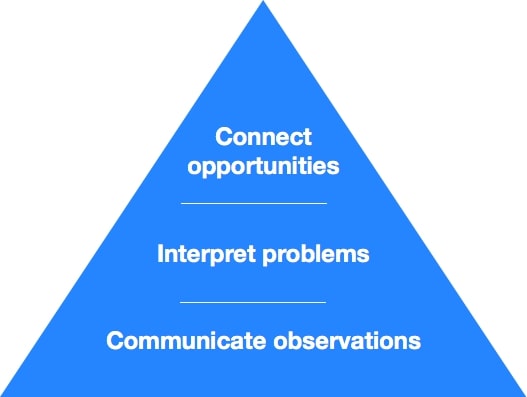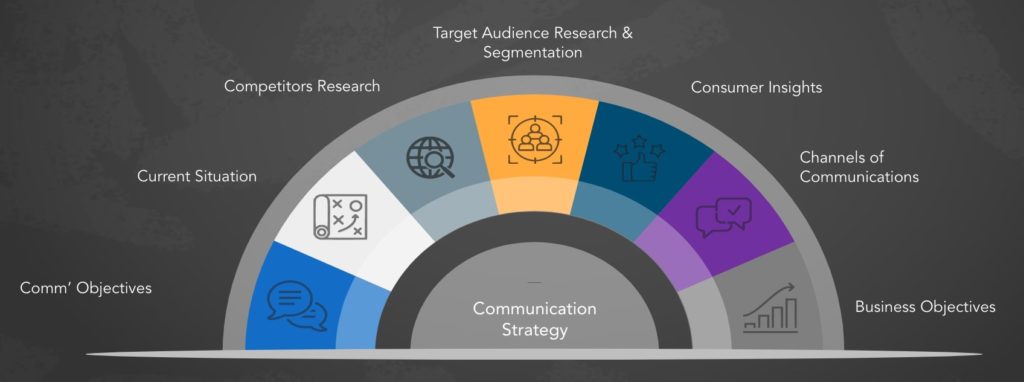Customer comments are essential to delivering a quality product as a product manager. When collecting data, it’s crucial to balance quantitative feedback that provides numerical insights with qualitative feedback.
Client interviews are an excellent way of collecting customer feedback to help development teams solve problems as they arise. Using the customer interview pyramid permits the collection of comments and allows teams to link opportunities to issues and offer solutions.
To learn more via video, watch below. Otherwise, skip ahead.
The Pyramid Principle
A pyramid principle is a tool that helps businesses communicate complex issues in a clear and concise manner. It is effective when a company uses case interviews to understand clients’ needs and when you want to make a persuasive argument when presenting.
We use pyramid principles when communicating in an organized manner with all sorts of people, be it with business executives, clients, and team members. It allows teams to disseminate key information in a contextualized, brief, and clear manner.
In a customer interview setting, the pyramid serves to collect contextual information before communicating issues of the greatest importance.
The Customer Interview Pyramid Principle
The simple customer interview pyramid framework has three layers:
- Connect opportunities
- Interpret problems
- Communicate observations

Credits: Medium
Working from the bottom up, this process allows teams to collect observations from clients and communicate them to the team. That way, the team understands any problems that occur throughout the project. This approach also allows the team to find solutions to these problems.
Communicating Observations
Teams collect observations from answers customers give to interview questions either through informal interviews or more formal information-collecting exercises. The interviewer doesn’t require substantial experience except to repeat what they have observed.

Interpreting Problems
Once the team collects the observations, they must then dedicate time to assessing users’ behaviors and collating them into a group of problem statements. It’s best to undertake this job as a collaborative job with a cross-team approach to allow visibility by grouping each observation into its problem statement.
Connecting Opportunities
The top of the customer interview pyramid principle is where they add value. A team connects an opportunity with a problem statement and comes up with a solution. This allows a job to develop by influencing the roadmap and understanding whether or not there is a need to re-prioritize.
Putting the Customer Interview Pyramid Into Action
To provide the team with the best level of insight after undertaking consulting interviews, follow these tips:
- Do not share your customer interview notes with the rest of the team straight away. This does not add value or offer the qualitative level of insight required.
- Analyze your notes yourself first. Consider observations you’ve made and put those with common issues in groups.
- Rather than creating a problem statement that turns into a feature request, reflect on the interview and consider the customer’s intention. Ask yourself what the customers are trying to achieve and what stops them from doing so. This creates your problem statement.
- Once you’ve identified the problem statement, connect opportunities with it to solve the problem.
- Spend time with your team to find a way to communicate best what you have learned from your customer interviews.
Implementing the Customer Interview Pyramid With Your Team
One of the best ways to roll out the pyramid principle for a case interview across a product development team is to create a template document that outlines the process.
This allows any person on the team to pick up the process and create a case study to develop a business case for creating problem statements and identifying opportunities.
This template is a simple word document that outlines the pyramid principle. However, some companies find it beneficial to create an online framework that includes a guide to customer interviews, tactics to get the level of insight you require, and examples of previous customer interviews.
The Customer Interview Template
An effective customer interview template features the following structure to help form your interview questions:
Background
Ask why the interview is taking place. Find out who the person you’re speaking to is and what their job is. How does that role enable them to use your product? Getting as much background about the person you’re interviewing and their job sets the context for the conversation and helps you understand their problems.
The Company
Gain further context by finding out the background of the company using your product or that you’re developing for. Asking interview questions to understand the company’s industry, how they’re placed in it, and how that impacts the problems they’re facing adds excellent insight that adds value.
Problems Observed
Once you’ve conducted the interview, list out the problems observed in the conversation as simple bullet points, or in the form of a contents page.
These only need a title at this time.
Sorting the Problems
A concise problem statement then summarizes each problem. It’s essential to be brief and articulate what the end-user wants to achieve and the situation they seek to resolve. Don’t compile a list of feature requests.
Back up what you have observed to show that there is a problem. Use recordings, screenshots, and any practical example to provide the required context for the reader.
Logging Opportunities
Log all possible solutions that the team has at their disposal to solve a problem. Create a spreadsheet and share it with your team members if you don’t have specialized software. Connect the opportunities to the issues to help the team understand how this is done.
Using shared software or documents allows team members to gain the required context from the initial customer interviews straight away regarding how they discover the problem and how the opportunity connects with it.
The Interview Write-Up
The interview’s write-up is in the form of several “Observation -> Problem -> Opportunity” statements. This clear and concise framework articulates the knowledge you gained from the customer interview and is helpful in turning these insights into action.
The Value of the Customer Interview Pyramid
Customer interviews are a precious tool in the arsenal of a product manager. They add context and quality to quantitative analysis and help manage the sightline between problems and solutions than simple customer surveys and questionnaires.
Applying the pyramid principle to a case interview provides an excellent framework to lead to valuable results that gives valuable insight to the interviewer when connecting opportunities to problems and helps build a rapport with clients. This leads to successful outcomes and the efficient solving of problems identified through the customer interview process.
